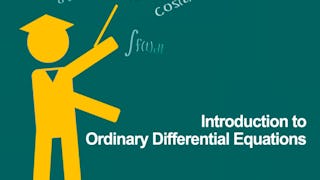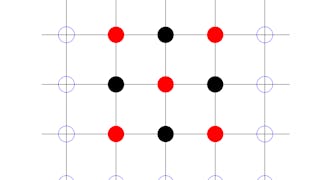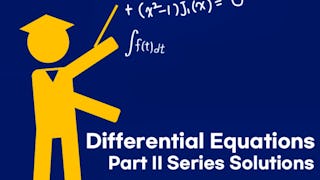In diesem Kurs dreht sich alles um Differentialgleichungen und umfasst sowohl Theorie als auch Anwendungen. In den ersten fünf Wochen lernen die Studenten gewöhnliche Differentialgleichungen kennen, während die sechste Woche eine Einführung in partielle Differentialgleichungen ist. Der Kurs umfasst 56 prägnante Vorlesungsvideos mit einigen Aufgaben, die nach jeder Vorlesung zu lösen sind. Nach jedem wichtigen Thema gibt es ein kurzes Übungsquiz. Am Ende jeder Woche gibt es ein bewertetes Quiz. Die Lösungen zu den Aufgaben und Übungsquiz finden Sie in den vom Kursleiter zur Verfügung gestellten Vorlesungsunterlagen.



Differentialgleichungen für Ingenieure
Dieser Kurs ist Teil von Spezialisierung Mathematik für Ingenieure

Dozent: Jeffrey R. Chasnov
TOP-LEHRKRAFT
67.994 bereits angemeldet
Bei  enthalten
enthalten
(2,137 Bewertungen)
Empfohlene Erfahrung
Was Sie lernen werden
Differentialgleichungen erster Ordnung
Differentialgleichungen zweiter Ordnung
Die Laplace-Transformation und Reihenlösungsmethoden
Systeme von Differentialgleichungen und partielle Differentialgleichungen
Kompetenzen, die Sie erwerben
- Kategorie: Infinitesimalrechnung
- Kategorie: Mathematik
- Kategorie: Problemlösung
- Kategorie: Kritisches Denken
- Kategorie: Lineare Algebra
- Kategorie: Mathematische Theorie & Analyse
Wichtige Details

Zu Ihrem LinkedIn-Profil hinzufügen
28 Quizzes, 3 Aufgaben
Erfahren Sie, wie Mitarbeiter führender Unternehmen gefragte Kompetenzen erwerben.


Erweitern Sie Ihre Fachkenntnisse
- Lernen Sie neue Konzepte von Branchenexperten
- Gewinnen Sie ein Grundverständnis bestimmter Themen oder Tools
- Erwerben Sie berufsrelevante Kompetenzen durch praktische Projekte
- Erwerben Sie ein Berufszertifikat zur Vorlage




Erwerben Sie ein Karrierezertifikat.
Fügen Sie diese Qualifikation zur Ihrem LinkedIn-Profil oder Ihrem Lebenslauf hinzu.
Teilen Sie es in den sozialen Medien und in Ihrer Leistungsbeurteilung.


In diesem Kurs gibt es 6 Module
Eine Differentialgleichung ist eine Gleichung für eine Funktion mit einer oder mehreren ihrer Ableitungen. Wir stellen verschiedene Arten von Differentialgleichungen vor und wie man sie klassifiziert. Anschließend besprechen wir die Euler-Methode zur numerischen Lösung einer gewöhnlichen Differentialgleichung (ODE) erster Ordnung. Wir lernen analytische Methoden zur Lösung von trennbaren und linearen ODEs erster Ordnung kennen, mit einer Erklärung der Theorie, gefolgt von illustrativen Lösungen einiger einfacher ODEs. Schließlich untersuchen wir drei reale Beispiele für ODEs erster Ordnung: Zinseszins, die Endgeschwindigkeit einer fallenden Masse und die elektrische Schaltung mit Widerstand und Kondensator.
Das ist alles enthalten
14 Videos14 Lektüren6 Quizzes1 Aufgabe
Wir verallgemeinern die numerische Euler-Methode auf eine ODE zweiter Ordnung. Anschließend entwickeln wir zwei theoretische Konzepte, die für lineare Gleichungen verwendet werden: das Prinzip der Überlagerung und den Wronskian. Mit diesen Konzepten können wir analytische Lösungen für eine homogene ODE zweiter Ordnung mit konstanten Koeffizienten finden. Wir verwenden einen exponentiellen Ansatz und transformieren die ODE mit konstanten Koeffizienten in eine Polynomgleichung zweiter Ordnung, die charakteristische Gleichung der ODE. Die charakteristische Gleichung kann reelle oder komplexe Wurzeln haben und wir lernen Lösungsmethoden für die verschiedenen Fälle.
Das ist alles enthalten
11 Videos11 Lektüren4 Quizzes1 Plug-in
Wir fügen nun der ODE mit konstantem Koeffizienten einen inhomogenen Term hinzu. Der inhomogene Term kann ein Exponentialwert, ein Sinus oder Kosinus oder ein Polynom sein. Wir untersuchen auch das Phänomen der Resonanz, wenn die erzwungene Frequenz gleich der natürlichen Frequenz des Oszillators ist. Schließlich lernen wir drei wichtige Anwendungen kennen: den RLC-Stromkreis, eine Masse an einer Feder und das Pendel.
Das ist alles enthalten
12 Videos9 Lektüren5 Quizzes
Wir stellen zwei neue analytische Lösungsmethoden zur Lösung von linearen ODEs vor. Die erste ist die Laplace-Transformationsmethode, die zur Lösung der ODE mit konstantem Koeffizienten und einem diskontinuierlichen oder impulsiven inhomogenen Term verwendet wird. Die Laplace-Transformation ist im Allgemeinen ein gutes Mittel, um anspruchsvolle Integraltransformationstechniken in einem leicht verständlichen Kontext einzuführen. Wir führen auch die Lösung einer linearen ODE durch eine Serienlösung ein. Obwohl wir hier nicht näher darauf eingehen, kann eine Einführung in diese Technik für Studenten nützlich sein, die ihr in fortgeschritteneren Kursen wieder begegnen.
Das ist alles enthalten
11 Videos10 Lektüren4 Quizzes1 Aufgabe
Wir lernen, wie man ein gekoppeltes System von homogenen Differentialgleichungen erster Ordnung mit konstanten Koeffizienten löst. Dieses System von ODEs kann in Matrixform geschrieben werden, und wir lernen, wie man diese Gleichungen in ein Standard-Eigenwertproblem der Matrixalgebra umwandelt. Die zweidimensionalen Lösungen werden dann mithilfe von Phasenporträts visualisiert. Als nächstes lernen wir die wichtige Anwendung gekoppelter harmonischer Oszillatoren und die Berechnung von Normalmoden kennen. Die Normalmoden sind die Bewegungen, bei denen die einzelnen Massen, aus denen das System besteht, mit der gleichen Frequenz schwingen. Anschließend wenden wir die Theorie an, um ein System aus zwei gekoppelten harmonischen Oszillatoren zu lösen, und verwenden die Normalmoden, um die Bewegung des Systems zu analysieren.
Das ist alles enthalten
13 Videos10 Lektüren4 Quizzes1 Aufgabe
Um zu lernen, wie man eine partielle Differentialgleichung (PDE) löst, definieren wir zunächst eine Fourier-Reihe. Dann leiten wir die eindimensionale Diffusionsgleichung ab, eine PDE, die die Diffusion eines Farbstoffs in einem Rohr beschreibt. Anschließend lösen wir diese PDE mit der Methode der Trennung der Variablen. Dabei wird die PDE in zwei gewöhnliche Differentialgleichungen (ODEs) aufgeteilt, die dann mit den Standardtechniken zur Lösung von ODEs gelöst werden können. Anschließend verwenden wir die Lösungen dieser beiden ODEs und unsere Definition einer Fourier-Reihe, um die Lösung der ursprünglichen PDE zu ermitteln.
Das ist alles enthalten
11 Videos11 Lektüren5 Quizzes
Dozent

TOP-LEHRKRAFT
Empfohlen, wenn Sie sich für Mathematik und Logik interessieren


Korea Advanced Institute of Science and Technology(KAIST)


The Hong Kong University of Science and Technology


Korea Advanced Institute of Science and Technology(KAIST)


Korea Advanced Institute of Science and Technology(KAIST)
Warum entscheiden sich Menschen für Coursera für ihre Karriere?




Bewertungen von Lernenden
2.137 Bewertungen
- 5 stars
88,49 %
- 4 stars
9,86 %
- 3 stars
1,26 %
- 2 stars
0,04 %
- 1 star
0,32 %
Zeigt 3 von 2137 an
Geprüft am 1. Dez. 2024
The professor is really good at teaching. Examples are easy to understand. Practices are not very hard but require some effort and need you to understand the concepts and methods. Great experience!
Geprüft am 27. Aug. 2020
I think this course is very suitable for any curious mind. You can learn very important and necessary concepts with this course.The courses taught by Professor Dr. Chasnov are excellent.
Geprüft am 9. Juli 2023
Great Courde by Dr. Chasnov as usual. Interesting topics and excellent material to further our own development. The course is broad in scope, difficult in some topics but great otherwise.



Neue Karrieremöglichkeiten mit Coursera Plus
Unbegrenzter Zugang zu 10,000+ Weltklasse-Kursen, praktischen Projekten und berufsqualifizierenden Zertifikatsprogrammen - alles in Ihrem Abonnement enthalten

Bringen Sie Ihre Karriere mit einem Online-Abschluss voran.
Erwerben Sie einen Abschluss von erstklassigen Universitäten – 100 % online

Schließen Sie sich mehr als 3.400 Unternehmen in aller Welt an, die sich für Coursera for Business entschieden haben.
Schulen Sie Ihre Mitarbeiter*innen, um sich in der digitalen Wirtschaft zu behaupten.
Häufig gestellte Fragen
Der Zugang zu Vorlesungen und Aufgaben hängt von der Art Ihrer Einschreibung ab. Wenn Sie einen Kurs im Prüfungsmodus belegen, können Sie die meisten Kursmaterialien kostenlos einsehen. Um auf benotete Aufgaben zuzugreifen und ein Zertifikat zu erwerben, müssen Sie die Zertifikatserfahrung während oder nach Ihrer Prüfung erwerben. Wenn Sie die Prüfungsoption nicht sehen:
Der Kurs bietet möglicherweise keine Prüfungsoption. Sie können stattdessen eine kostenlose Testversion ausprobieren oder finanzielle Unterstützung beantragen.
Der Kurs bietet möglicherweise stattdessen die Option 'Vollständiger Kurs, kein Zertifikat'. Mit dieser Option können Sie alle Kursmaterialien einsehen, die erforderlichen Bewertungen abgeben und eine Abschlussnote erhalten. Dies bedeutet auch, dass Sie kein Zertifikat erwerben können.
Wenn Sie sich für den Kurs einschreiben, erhalten Sie Zugang zu allen Kursen der Specializations, und Sie erhalten ein Zertifikat, wenn Sie die Arbeit abgeschlossen haben. Ihr elektronisches Zertifikat wird Ihrer Erfolgsseite hinzugefügt - von dort aus können Sie Ihr Zertifikat ausdrucken oder zu Ihrem LinkedIn-Profil hinzufügen. Wenn Sie die Kursinhalte nur lesen und ansehen möchten, können Sie den Kurs kostenlos besuchen.
Wenn Sie ein Abonnement abgeschlossen haben, erhalten Sie eine kostenlose 7-tägige Testphase, in der Sie kostenlos kündigen können. Danach gewähren wir keine Rückerstattung, aber Sie können Ihr Abonnement jederzeit kündigen. Siehe unsere vollständigen Rückerstattungsbedingungen.

